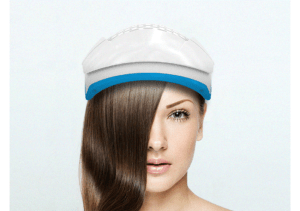Have you ever noticed more hair falling out during certain times of the year? You're not alone if you find extra strands on your hairbrush or pillow when the seasons change. Seasonal hair shedding, also known as seasonal hair loss, is a natural occurrence characterized by increased hair loss during specific times of the year. Seasonal hair loss is pretty normal and happens when a greater number of hair follicles enter the telogen (resting) phase of the hair growth cycle, leading to temporary shedding. During autumn and winter, many people notice increased shedding as their hair prepares for new growth cycles.
While it might seem alarming to see more hair shedding out during seasonal change, you can manage it with the right care. Simple steps like eating a balanced diet, being gentle with your hair, and using treatments that promote healthy hair regrowth can make a big difference. In this blog, we'll explore what causes seasonal hair loss and provide practical tips to minimize excessive hair fall during these transitional periods.
When Does Seasonal Hair Shedding Occur the Most?
Typically, seasonal hair shedding peaks during fall and spring. In the fall, around September to November, hair follicles that entered the telogen phase during the summer begin to shed. Many people notice that most hair fall occurs around October when the weather starts getting cooler, leading to cold-weather hair breakage. Similarly, in the spring, around March and April, the follicles that enter the telogen phase during winter are shed.
What Causes Seasonal Hair Loss?
Seasonal hair loss is typically a temporary condition and a natural response to environmental changes. Common factors include shifts in daylight, temperature fluctuations, exposure to UV radiation, and changes in humidity, which can influence the hair growth cycle.
On average, hair grows around 6 inches per year. However, during certain times of the year, more hair follicles enter the telogen (resting) phase, leading to increased shedding. Such type of weather-induced hair loss is different from chronic conditions like male and female pattern baldness, which are mainly driven by hormonal imbalances and genetic predisposition.
In addition to environmental factors, seasonal hair loss may also be influenced by dietary changes, stress levels, vitamin deficiencies, and alterations in overall health. Despite these factors, hair lost during seasonal shedding usually regrows as follicles transition back to the anagen (growth) phase.
Is Seasonal Hair Loss Normal?
Yes, experiencing seasonal hair shedding is normal for many individuals. This type of hair loss is usually temporary and should not result in significant or long-lasting hair thinning. As long as you maintain proper hair and scalp care, seasonal shedding typically poses no cause for concern. Seasonal hair loss is a natural part of the hair shedding cycle and usually resolves on its own without any intervention.
How Long Does Seasonal Hair Loss Last?
Seasonal hair loss typically occurs for a few weeks to a couple of months for most people. During this time, you may notice more hair falling out when you brush or wash your hair. Hair shedding happens as your body adjusts to the changing seasons, much like how trees lose their leaves. The good news is that seasonal hair loss is temporary, and your hair growth will return to normal. While it might feel worrying to see extra hair in your brush or shower drain, remember that this is your body's natural cycle and not a sign of permanent hair loss or alopecia.
How Seasonal Changes Influence Our Hair Growth Cycle?
Seasonal changes can have a noticeable impact on our hair growth cycle. In warmer months like spring and summer, more hair stays in the growing phase because the body naturally works to protect the scalp from sun exposure. This is why hair might feel thicker or healthier during these times. The increased daylight and vitamin D from sunlight also support hair growth.
As the seasons shift to autumn and winter, the hair growth cycle changes. More hair enters the resting phase, leading to more shedding. Seasonal hair shedding happens because the body no longer needs as much protection for the scalp. Cooler weather and lower humidity can also make the scalp dry, which might affect hair health. These changes are part of a natural cycle and are usually temporary.
Seasonal Hair Loss Vs Telogen Effluvium
While seasonal hair loss and telogen effluvium may share similarities, they represent distinct phenomena.
Seasonal hair loss refers to the increased hair shedding some individuals experience during specific times of the year, typically in fall or autumn. This natural process is influenced by changes in environmental factors such as temperature, daylight, and seasonal transitions, which affect the hair growth cycle.
Telogen Effluvium, on the other hand, is a specific condition characterized by an abnormal increase in hair shedding due to a large number of hair follicles entering the telogen (resting) phase prematurely. This type of hair loss is often triggered by physiological or emotional stress, such as illness, trauma, or significant life changes.
How to Stop Seasonal Hair Loss?
Seasonal hair loss can become more pronounced if hair and scalp health are not properly maintained. While our ancestors might have relied on their hair for camouflage in the wild, today we value hair for its role in enhancing our appearance and self-confidence. Ensuring your hair remains vibrant and healthy is essential, especially as you approach the times of year known for increased shedding.
As such, if the changing seasons seem to affect your hair more than you'd like, there are proactive steps to stop seasonal hair loss and maintain hair health. Here are four key strategies to help prepare for and manage seasonal hair loss, keeping your hair thick, healthy, and full.
1. Pay attention to your hair shedding

It's normal to lose a certain number of hairs each day, with an average range typically between 80 and 150 hairs. During seasonal hair shedding phases, you may notice an increase in hair loss. Pay attention to the hair on your brush, pillowcases, and in the shower drain.
Keep in mind that genetics play a significant role in how much hair you shed, so individual experiences can vary. If you notice an unusually high amount of hair loss, especially if it seems excessive compared to your normal shedding, it might be worth investigating further.
Hair loss during showers is quite common, but if you’re unsure whether it’s a sign of a more serious issue, consult our article on hair loss in the shower for more information. If you’re concerned about significant hair loss, it’s best to consult a healthcare professional. They can help rule out any underlying health issues, as hair loss can sometimes be an indicator of your body prioritizing essential functions over hair growth.
2. Take natural supplements that promote hair growth

Natural supplements can strengthen hair and scalp health, particularly during hair shedding phases. Key supplements often mentioned include biotin, selenium, and zinc. However, it's important to note that while these supplements may help support healthy hair growth and scalp, there is no conclusive evidence that they promote hair growth. In fact, biotin is not specifically advocated, as its effectiveness in growing hair has not been proven.
Incorporating these nutrients through diet or supplements may be beneficial, but always consult a physician before starting any new supplements, especially if you are taking medication, pregnant, or have existing health conditions.
Biotin, a water-soluble vitamin B
Biotin, a water-soluble B vitamin, is often promoted for its role in supporting healthy hair growth, scalp, skin, nails, immune function, and cellular energy production. Albeit, while biotin may help support hair health, there is no conclusive evidence that it enhances hair growth or strength in individuals without a biotin deficiency. Additionally, it cannot reverse existing hair loss or combat factors that exacerbate it. Biotin deficiency is rare, but if present, it may contribute to increased hair shedding. For most people, supplementation is unnecessary, and high doses, such as 10,000 mcg daily, are not typically recommended without medical advice.
Find more about biotin deficiency hair loss.
Selenium
Selenium plays a role in supporting overall scalp health by reducing the Malassezia fungus, which can contribute to dandruff, scalp inflammation, and potential hair loss. It is also included in some anti-dandruff shampoos. While selenium can help maintain a healthy scalp environment, there is no definitive evidence that it directly supports healthy hair growth or prevents excessive seasonal hair shedding. During hair shedding seasons, a daily dose of 100 to 250 mcg of selenium is often suggested, but its effectiveness in promoting hair growth is not firmly established.
Zinc
Zinc is a crucial trace mineral that supports protein synthesis, cell reproduction, tissue growth, vitamin absorption, and hormonal balance. It strengthens hair shafts, boosts the immune system, and maintains scalp health by regulating sebum production. Involving 30 mg of zinc into your daily routine during hair shedding season can help promote hair regrowth and maintain overall scalp health.
3. Prepare for seasonal hair shedding ahead of time

Now is the time to put your plans into action and prepare for the upcoming hair shedding seasons. By marking the anticipated periods of increased shedding on your calendar, you can proactively manage the process. Equip yourself with a supply of beneficial supplements and consider implementing an FDA-cleared hair growth device like Theradome into your routine.
The Theradome, engineered in the U.S., uses proven scientific technology to help prevent and reverse hair loss. Its wearable, cordless design ensures ease of use, making it a convenient addition to your daily regimen, particularly during the hair shedding seasons. By preparing ahead of time, you can better manage and mitigate the effects of seasonal hair loss.
4. Use the Theradome Laser Helmet consistently

Laser hair therapy is clinically proven to reduce seasonal hair shedding, increase hair shaft diameter, and stimulate new hair growth. To effectively manage seasonal hair shedding, consider incorporating the FDA-cleared Theradome PRO or EVO into your routine. These devices are among the most advanced laser hair therapy solutions available to you and offer a cost-effective alternative to professional laser hair clinics.
The Theradome helmet delivers powerful laser therapy that can help you stay ahead of seasonal hair loss. For optimal results, use the helmet twice a week to maximize its benefits and support hair rejuvenation. Don’t settle for less when you can enhance your hair health with cutting-edge technology. Embrace the future of hair care and achieve fuller, healthier locks with the Theradome laser helmet.
Conclusion
Understanding seasonal hair loss helps you feel more confident about managing your hair's natural changes throughout the year. Remember that losing some extra hair during fall and spring is completely normal and not a reason to worry. You can support your hair's health during these seasonal shifts by paying attention to your hair, maintaining a healthy diet, considering natural supplements, and using hair care techniques.
The key is to stay patient and kind to yourself, knowing that your body is simply going through its natural hair shedding cycle. With the right approach and understanding, you can navigate seasonal hair shedding smoothly and maintain healthy, beautiful hair all year round.






















